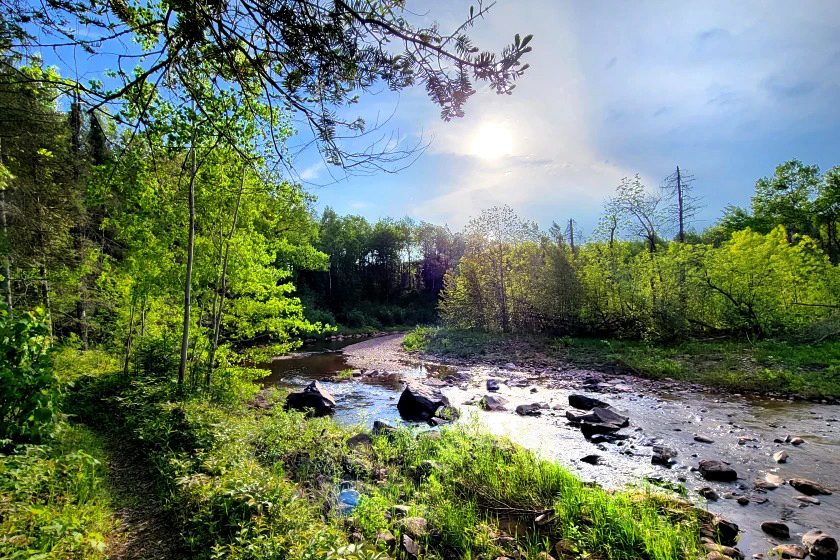KNIFE RIVER, Minn. — Low flows and warmer water temperatures are a big problem for brook trout in the streams of Minnesota’s North Shore of Lake Superior, threatening their future existence if they can’t find cold-water pools to thrive in.
That’s why researchers this summer will start following more than 2,500 trout in the Knife and Stewart rivers — both brook trout and migratory steelhead rainbow trout — to see where they go when times get tough.
A major new study will begin in the spring of 2024 to find the last, best places producing cold water refuges for trout in two North Shore streams. The research is a cooperative effort between the University of Wisconsin-Stevens Point, the Minnesota Department of Natural Resources and several conservation and trout fishing groups. (Courtesy of the Minnesota Department of Natural Resources)
“We think the fish will show us where those cold-water refuges are that will be critical for trout to survive in future decades,” said Justin VanDeHey, a fisheries scientist at the University of Wisconsin-Stevens Point. “If we can locate where the cold water is, we can focus efforts to protect those spots where they are most needed, especially for brook trout.”
With help from the Minnesota Department of Natural Resources and local trout fishing and conservation groups, VanDeHey and his team will place tags inside 1,800 trout in the Knife River and another 700 in the Stewart. The tags will send signals to receivers placed along the rivers in various locations. Every time the fish swims by, it will send a signal to the receiver.
“Sort of like a grocery store checkout moving items across the scanner,” VanDeHey said.
Researchers will also place another 60 GPS transmitting tags in trout so they can follow them in real time wherever they go.
The crews will be taking water temperature readings at multiple locations along the streams to better pinpoint where those cold-water springs are located.
Officials involved in the project held an open house Tuesday for anyone who wanted to learn more or help out.
The study, funded by the U.S. Fish and Wildlife Service from the Great Lakes Fish and Wildlife Restoration Act, notes that North Shore streams are especially vulnerable to trends taking hold under climate change — namely warmer temperatures, more droughts and erratic rainfall. Biologists say there will likely be a 20% to 80% reduction in brook trout in North Shore streams within 50 years due to climate change.
“Our goal is to try to keep that to the low end,” VanDeHey said.
Unlike, say, Wisconsin’s Bois Brule River, which gets a constant, cold source of water from underground springs, most of the flow in North Shore streams comes from the headwaters of the rivers, namely swamps and lakes inland from the North Shore’s steep hills. But when those swamps and lakes hit low water conditions, they send little or no water down the streams toward Lake Superior.
“That’s when those cold-water refuges become most important,” VanDeHey said.
That could happen this year, with drought conditions setting in across the Northland and virtually no snow to melt to bolster stream flow, said Nick Peterson, Minnesota DNR fisheries specialist based in Knife River.
“It’s the opposite of the extreme flows we had last spring from the record snow and heavy rain. And that’s why you try to work across several years, to capture the varied conditions the streams see, all of the extremes,” Peterson said.
A big Knife River steelhead caught in 2026. A new 2024 research project will spend several years tracking trout and water temperatures along the Knife and Stewart rivers on the North Shore to see where the best cold-water refuges are located. (Sam Cook / Duluth News Tribune)
Crews this summer will begin using backpack electro-shocking devices that stun the fish, allowing them to be scooped up so the transmitters can be inserted and the fish released back into the streams. They also hope to use the DNR’s Knife River fish trap to capture fish to insert transmitters. Scientists will then follow the fish for at least two and maybe three growing seasons.
Millions of dollars have been pumped into restoration efforts along North Shore streams, especially the Knife River, and scientists also want to know if fish are indeed benefiting from those efforts.
They also hope to learn how much overlap exists between brook, rainbow and brown trout in the same streams. Only brook trout are native to the North Shore streams. They also hope to compare how brook trout are doing in the Stewart, which has no steelhead or brown trout, and the Knife, which has all three.
Other groups involved in the trout study include the Minnesota Pollution Control Agency, Lake Superior Steelheaders Association, Minnesota Trout Unlimited, the Arrowhead Fly Fishers, Advocates for the Knife River Watershed, Minnesota Steelheader and the Two Harbors High School Enviro Club.
“There’s a lot of physical work that’s going to be needed putting in the arrays (receiving antennas) and making sure they stay in place,” VanDeHey said. “We are going to need a lot of help, and we think we have it lined up.”
For more information about the project, contact Peterson at nick.peterson@state.mn.us or 218-302-3272.
Related Articles
Mild winter likely set stage for Lake Traverse fish kill
Minnesota lake ice-out starts month early
DNR tightens open water fishing regulations for Upper Red Lake
Minnesota DNR says Mille Lacs walleye fishing will be catch-and-release until mid-August
These 5 Colorado dude ranches are spectacular in winter


Leave a Reply